An Electrochemical Study of the Corrosion Behaviour of the Polished Atomic Diffusion Additive Manufactured 17-4PH Stainless Steel Using Centrifugal Mass Finishing Method in Saltwater
Abstract
1. Introduction
2. Experimental Setup
2.1. Sample Preparation
2.2. Centrifugal Disc Finishing and Measurements
2.3. Corrosion Behaviour Evaluation
2.4. Material Characterisation
3. Results
3.1. Sample Characterisation
3.2. Electrochemical Analyses
3.2.1. AEN Analyses
3.2.2. PPC Assessments
3.2.3. EIS Evaluation
3.2.4. Mott-Schoktty Method Analyses
3.3. Surface Analysis After Corrosion (PPC) Test
4. Discussion
5. Conclusions
- Polished samples demonstrate a higher thermodynamic corrosion resistance and enhanced capacity of spontaneous regeneration of the oxidised layer (−0.297 V and 0 V obtained from PPC) compared to non-polished surfaces. This improvement is attributed to the abrasive polishing process, which reduces the surface imperfections, including roughness, chemical heterogeneity, and cracks. These defects significantly affect the stability of the oxidised layer (Flat band potential range from −0.27 V to 0.31 V for non-polished, and from −2.97 V to 0.42 V for polished, values obtained from Mott-Schottky).
- The temporal evolution of the corrosion mechanism was strongly influenced by the surface condition. Non-polished samples displayed a continuous degradation of the oxidised layer (from 56.44 Ωcm−2 to 5.16 Ωcm−2 obtained from EIS). The high surface roughness promotes microgalvanic cell formation, which enhances the chemical reactivity of the oxidised layer and its dissolution. In contrast, polished surfaces exhibited no diffusion-controlled processes over time. For immersion periods shorter than 48 h, the corrosion resistance of the oxidised layer increased progressively (from 13.61 Ωcm−2 to 1220.00 Ωcm−2 obtained from EIS) with the immersion time.
- The pitting corrosion was identified as the dominant localised corrosion type for both sample types (0.52 and 0.15 calculated from AEN for non-polished and polished). The pits contained ε-copper precipitate with high copper concentration, accelerating the corrosion rate through its cathodic effect on the iron matrix. The polished surface exhibited a lower number of pits compared to the non-polished surface, indicating an improvement in the local corrosion resistance.
Supplementary Materials
Author Contributions
Funding
Data Availability Statement
Conflicts of Interest
References
- Gibson, I.; Rosen, D.; Stucker, B.; Khorasani, M.; Rosen, D.; Stucker, B.; Khorasani, M. Additive Manufacturing Technologies; Springer: Cham, Switzerland, 2021; Volume 17. [Google Scholar]
- Ngo, T.D.; Kashani, A.; Imbalzano, G.; Nguyen, K.T.; Hui, D. Additive manufacturing (3D printing): A review of materials, methods, applications and challenges. Compos. Part B Eng. 2018, 143, 172–196. [Google Scholar] [CrossRef]
- Thompson, M.K.; Moroni, G.; Vaneker, T.; Fadel, G.; Campbell, R.I.; Gibson, I.; Bernard, A.; Schulz, J.; Graf, P.; Ahuja, B. Design for Additive Manufacturing: Trends, opportunities, considerations, and constraints. CIRP Ann. 2016, 65, 737–760. [Google Scholar] [CrossRef]
- Gonzalez-Gutierrez, J.; Cano, S.; Schuschnigg, S.; Kukla, C.; Sapkota, J.; Holzer, C. Additive manufacturing of metallic and ceramic components by the material extrusion of highly-filled polymers: A review and future perspectives. Materials 2018, 11, 840. [Google Scholar] [CrossRef]
- Kong, D.; Ni, X.; Dong, C.; Zhang, L.; Man, C.; Cheng, X.; Li, X. Anisotropy in the microstructure and mechanical property for the bulk and porous 316L stainless steel fabricated via selective laser melting. Mater. Lett. 2019, 235, 1–5. [Google Scholar] [CrossRef]
- Ahuir-Torres, J.I.; Gibbons, G.J.; West, G.; Das, A.; Kotadia, H.R. Understanding the corrosion behaviour of Al-Mg alloy fabricated using a Laser Powder Bed Fusion (L-PBF) Additive Manufacturing (AM) process. J. Alloys Compd. 2023, 969, 172300. [Google Scholar] [CrossRef]
- Voisin, T.; Shi, R.; Zhu, Y.; Qi, Z.; Wu, M.; Sen-Britain, S.; Zhang, Y.; Qiu, S.; Wang, Y.; Thomas, S. Pitting corrosion in 316L stainless steel fabricated by laser powder bed fusion additive manufacturing: A review and perspective. JOM 2022, 74, 1668–1689. [Google Scholar] [CrossRef]
- Sander, G.; Thomas, S.; Cruz, V.; Jurg, M.; Birbilis, N.; Gao, X.; Brameld, M.; Hutchinson, C. On the corrosion and metastable pitting characteristics of 316L stainless steel produced by selective laser melting. J. Electrochem. Soc. 2017, 164, C250. [Google Scholar] [CrossRef]
- Atzeni, E.; Genna, S.; Menna, E.; Rubino, G.; Salmi, A.; Trovalusci, F. Surface finishing of additive manufactured ti-6al-4v alloy: A comparison between abrasive fluidized bed and laser finishing. Materials 2021, 14, 5366. [Google Scholar] [CrossRef]
- Gillespie, L. Mass Finishing Handbook; Industrial Press Inc.: South Norwalk, CT, USA, 2007. [Google Scholar]
- Boschetto, A.; Bottini, L.; Macera, L.; Veniali, F. Post-processing of complex SLM parts by barrel finishing. Appl. Sci. 2020, 10, 1382. [Google Scholar] [CrossRef]
- Opoz, T.T.; Burgess, A.; Ahuir-Torres, J.I.; Kotadia, H.R.; Tammas-Williams, S. The effect of surface finish and post-processing on mechanical properties of 17-4 PH stainless steel produced by the atomic diffusion additive manufacturing process (ADAM). Int. J. Adv. Manuf. Technol. 2024, 130, 4053–4066. [Google Scholar] [CrossRef]
- Auguste, P.; Mauduit, A.; Fouquet, L.; Pillot, S. Study on 17-4PH stainless steel produced by selective laser melting. UPB Sci. Bull. Ser. B Chem. Mater. Sci 2018, 80, 197–210. [Google Scholar]
- Bagehorn, S.; Wehr, J.; Maier, H.-J. Application of mechanical surface finishing processes for roughness reduction and fatigue improvement of additively manufactured Ti-6Al-4V parts. Int. J. Fatigue 2017, 102, 135–142. [Google Scholar] [CrossRef]
- Mwema, F.; Wambua, J.; Bodunrin, M.O.; Akinlabi, S.; Jen, T.-C.; Akinlabi, E. Thermal fluctuations on the corrosion behaviour of 17-4PH stainless steel alloys fabricated via material extrusion additive manufacturing technique. Proc. Inst. Mech. Eng. Part L J. Mater. Des. Appl. 2025, 239, 746–759. [Google Scholar] [CrossRef]
- Naim, M.; Chemkhi, M.; Alhussein, A.; Retraint, D. Effect of post-treatments on the tribological and corrosion behavior of 17–4PH stainless steel processed via fused filament fabrication. Addit. Manuf. Lett. 2023, 7, 100158. [Google Scholar] [CrossRef]
- Świetlicki, A.; Walczak, M.; Szala, M. Corrosion Resistance of Additive Manufactured 17-4PH DMLS Steel After Heat Treatment And Shot Peening Process. Acta Mech. Autom. 2025, 19, 205–211. [Google Scholar] [CrossRef]
- Sabooni, S.; Chabok, A.; Feng, S.; Blaauw, H.; Pijper, T.; Yang, H.; Pei, Y. Laser powder bed fusion of 17-4PH stainless steel: A comparative study on the effect of heat treatment on the microstructure evolution and mechanical properties. Addit. Manuf. 2021, 46, 102176. [Google Scholar]
- Martins, M.F.; Martínez, R.D.O.; Revilla, R.I.; De Graeve, I. Corrosion behavior of steel parts repaired using additive manufacturing: Overview and research perspective. Mater. Des. 2025, 252, 113769. [Google Scholar] [CrossRef]
- Jiang, D.; Ning, F. Physical-mechanical behaviors of stainless steel plate-lattice built by material extrusion additive manufacturing. J. Mater. Process. Technol. 2022, 309, 117739. [Google Scholar] [CrossRef]
- Liu, X.; Zhang, Q.; Chen, X. Modelling Centrifugal Disc Finishing Process Using the Fuzzy Rule-Based Method. In Proceedings of the 25th International Symposium on Advances in Abrasive Technology Conference Proceedings, Taiwan, China, 10–13 December 2023. [Google Scholar]
- Kearns, J.R.; Eden, D.A.; Yaffe, M.R.; Fahey, J.V.; Reichert, D.L.; Silverman, D.C. ASTM standardization of electrochemical noise measurement. In ASTM Special Technical Publication; ASTM International: West Conshohocken, PA, USA, 1996; Volume 1277, pp. 446–470. [Google Scholar]
- ASTM G61-86; Standard Test Method for Conducting Cyclic Potentiodynamic Polarization Measurements for Localized Corrosion Susceptibility of Iron-, Nickel-, or Cobalt-Based Alloys. ASTM International: West Conshohocken, PA, USA, 2009.
- ASTM G106-89; Standard Practice for Verification of Algorithm and Equipment for Electrochemical Impedance Measurements. ASTM International: West Conshohocken, PA, USA, 2009.
- Williamson, J.; Isgor, O. Investigation of Mott–Schottky analysis test parameters to study the semiconductive properties of passive films of carbon steel in highly alkaline environments. Adv. Civ. Eng. Mater. 2016, 5, 80–106. [Google Scholar] [CrossRef]
- Brown, C.U.; Brown, C.U.; Donmez, A. Microstructure Analysis for Additive Manufacturing: A Review of Existing Standards; U.S. Department of Commerce, National Institute of Standards and Technology: Gaithersburg, MD, USA, 2016.
- Pellegrini, A.; Lavecchia, F.; Guerra, M.G.; Galantucci, L.M. Influence of aging treatments on 17-4PH stainless steel parts realized using material extrusion additive manufacturing technologies. Int. J. Adv. Manuf. Technol. 2023, 126, 163–178. [Google Scholar] [CrossRef]
- Gong, C.; Djouda, J.M.; Hmima, A.; Gaslain, F.; Kauffmann, J.; Chemkhi, M.; Maurer, T.; Panicaud, B. Local characterization of stainless steel 17-4PH produced by material extrusion additive manufacturing: Influence of the post-treatment. Mater. Sci. Eng. A 2023, 880, 145371. [Google Scholar] [CrossRef]
- Promsuwan, P.; Tongsri, R.; Kowitwarangkul, P.; Ninpetch, P.; Threrujirapapong, T. Investigation on microstructure and mechanical properties of 17-4PH stainless steels fabricated by materials extrusion additive manufacturing. Songklanakarin J. Sci. Technol. 2023, 45, 442–450. [Google Scholar]
- Kareem, M.Q.; Mikó, T.; Gergely, G.; Gácsi, Z. A review on the production of 17-4PH parts using press and sinter technology. Sci. Prog. 2023, 106, 00368504221146060. [Google Scholar] [CrossRef] [PubMed]
- Xavier, L.M.; Neto, C.A.; Marins, A.A.; Strey, N.F.; Boher, C.; Scandian, C. Rotary barrel tumbling as a method of surface preparation for pin-on-disc wear testing samples. Surf. Topogr. Metrol. Prop. 2024, 12, 035028. [Google Scholar] [CrossRef]
- Sun, Y.; Hebert, R.J.; Aindow, M. Effect of heat treatments on microstructural evolution of additively manufactured and wrought 17-4PH stainless steel. Mater. Des. 2018, 156, 429–440. [Google Scholar] [CrossRef]
- Asami, K.; Lozares, J.M.C.; Ullah, A.; Bossen, B.; Clague, L.; Emmelmann, C. Material extrusion of metals: Enabling multi-material alloys in additive manufacturing. Mater. Today Commun. 2024, 38, 107889. [Google Scholar] [CrossRef]
- Ahuir-Torres, J.I.; Yang, X.; West, G.; Kotadia, H.R. Corrosion behaviour of SiC particulate reinforced AZ31 magnesium matrix composite in 3.5% NaCl with and without heat treatment. Mater. Chem. Phys. 2024, 320, 129467. [Google Scholar] [CrossRef]
- Milner, P.C. Interpretation of Measurements of Potential Decay on Open Circuit. J. Electrochem. Soc. 1960, 107, 343. [Google Scholar] [CrossRef]
- Kelly, R.G.; Scully, J.R.; Shoesmith, D.; Buchheit, R.G. Electrochemical Techniques in Corrosion Science and Engineering; CRC Press: Boca Raton, FL, USA, 2002. [Google Scholar]
- Mansfeld, F.; Sun, Z. Localization index obtained from electrochemical noise analysis. Corrosion 1999, 55, 915–918. [Google Scholar] [CrossRef]
- Souza, E.C.d.; Rossitti, S.M.; Fortulan, C.A.; Rollo, J.M.D.d.A. Influence of ferrite phase content on the electrochemical properties of duplex stainless steels. Mater. Res. 2016, 20, 21–29. [Google Scholar] [CrossRef]
- Ahuir-Torres, J.I.; Bausch, N.; Farrar, A.; Webb, S.; Simandjuntak, S.; Nash, A.; Thomas, B.; Muna, J.; Jonsson, C.; Mathew, D. Benchmarking parameters for remote electrochemical corrosion detection and monitoring of offshore wind turbine structures. Wind Energy 2019, 22, 857–876. [Google Scholar] [CrossRef]
- Li, W.; Li, D. Influence of surface morphology on corrosion and electronic behavior. Acta Mater. 2006, 54, 445–452. [Google Scholar] [CrossRef]
- Tullmin, M.; Roberge, P.R. Corrosion of metallic materials. IEEE Trans. Reliab. 1995, 44, 271–278. [Google Scholar] [CrossRef]
- Biserova-Tahchieva, A.; Biezma-Moraleda, M.V.; Llorca-Isern, N.; Gonzalez-Lavin, J.; Linhardt, P. Additive manufacturing processes in selected corrosion resistant materials: A state of knowledge review. Materials 2023, 16, 1893. [Google Scholar] [CrossRef]
- Xia, D.-H.; Song, S.; Behnamian, Y.; Hu, W.; Cheng, Y.F.; Luo, J.-L.; Huet, F. electrochemical noise applied in corrosion science: Theoretical and mathematical models towards quantitative analysis. J. Electrochem. Soc. 2020, 167, 081507. [Google Scholar] [CrossRef]
- Esmailzadeh, S.; Aliofkhazraei, M.; Sarlak, H. Interpretation of cyclic potentiodynamic polarization test results for study of corrosion behavior of metals: A review. Prot. Met. Phys. Chem. Surf. 2018, 54, 976–989. [Google Scholar] [CrossRef]
- Rodríguez, M.A.; Carranza, R.M.; Rebak, R.B. Passivation and depassivation of alloy 22 in acidic chloride solutions. J. Electrochem. Soc. 2009, 157, C1. [Google Scholar] [CrossRef]
- Olsson, C.-O.; Landolt, D. Passive films on stainless steels—Chemistry, structure and growth. Electrochim. Acta 2003, 48, 1093–1104. [Google Scholar] [CrossRef]
- Carvalho, R.N.; Troconis, B.C.R.; Pioszak, G.; Ynciarte, V.; Scully, J.R. Effect of microstructure on the pitting susceptibility of a martensitic-ferritic stainless steel: A corrosion-metallurgical study. Corros. Sci. 2022, 202, 110277. [Google Scholar] [CrossRef]
- Ahuir-Torres, J.; Meredith, A.; Batako, A.; Kotadia, H.; Opoz, T.; Zhu, G.; Khidasheli, N.; Sharp, M.; Bakradze, N. Corrosion behaviour of hardened grey cast iron with continuous-wave infrared laser. Mater. Today Commun. 2025, 44, 111852. [Google Scholar] [CrossRef]
- Frankel, G.S. Electrochemical techniques in corrosion: Status, limitations, and needs. J. Test. Eval. 2014, 42, 517–538. [Google Scholar] [CrossRef]
- Zhang, X.; Jiang, Z.H.; Yao, Z.P.; Song, Y.; Wu, Z.D. Effects of scan rate on the potentiodynamic polarization curve obtained to determine the Tafel slopes and corrosion current density. Corros. Sci. 2009, 51, 581–587. [Google Scholar] [CrossRef]
- Quevedo, M.C.; Galicia, G.; Mayen-Mondragon, R.; Llongueras, J.G. Role of turbulent flow seawater in the corrosion enhancement of an Al–Zn–Mg alloy: An electrochemical impedance spectroscopy (EIS) analysis of oxygen reduction reaction (ORR). J. Mater. Res. Technol. 2018, 7, 149–157. [Google Scholar] [CrossRef]
- Yati, M.S.D.; Derman, M.N.; Isa, M.C.; Mohammad, M.M.; Nain, H. Electrochemical characterisation of hybrid activators for aluminium sacrificial anodes in natural sea water. Def. S T Technol. Bull. 2013, 6, 78–92. [Google Scholar]
- Pathote, D.; Jaiswal, D.; Singh, V.; Behera, C. Optimization of electrochemical corrosion behavior of 316L stainless steel as an effective biomaterial for orthopedic applications. Mater. Today Proc. 2022, 57, 265–269. [Google Scholar] [CrossRef]
- Osório, W.R.; Peixoto, L.C.; Moutinho, D.J.; Gomes, L.G.; Ferreira, I.L.; Garcia, A. Corrosion resistance of directionally solidified Al–6Cu–1Si and Al–8Cu–3Si alloys castings. Mater. Des. 2011, 32, 3832–3837. [Google Scholar] [CrossRef]
- Hernández, H.H.; Reynoso, A.M.R.; Juan, C.; González, T.; Morán, C.O.G. Electrochemical Impedance Spectroscopy (EIS): A Review Study of Basic Aspects of the Corrosion Mechanism Applied to. In Electrochemical Impedance Spectroscopy; IntechOpen: London, UK, 2020; p. 1. [Google Scholar]
- McCafferty, E. AC impedance. In Introduction to Corrosion Science; Springer: New York, NY, USA, 2009; pp. 427–451. [Google Scholar]
- Li, Y.; Cai, J.; Guan, L.; Wang, G. pH-dependent electrochemical behaviour of Al3Mg2 in NaCl solution. Appl. Surf. Sci. 2019, 467, 619–633. [Google Scholar] [CrossRef]
- Memet, J.; Girault, P.; Sabot, R.; Compère, C.; Deslouis, C. Electrochemical impedance spectroscopy of a free-standing oxide film. Electrochim. Acta 2002, 47, 1043–1053. [Google Scholar] [CrossRef]
- Yuan, X.-Z.; Song, C.; Wang, H.; Zhang, J. Electrochemical Impedance Spectroscopy in PEM Fuel Cells; Springer: London, UK, 2020. [Google Scholar]
- Jangde, A.; Kumar, S.; Blawert, C. Correlative study of Mott–Schottky analysis and corrosion behaviour of plasma electrolytic oxidation treated magnesium alloy: Effect of Cl− concentrations. Corros. Sci. 2024, 240, 112386. [Google Scholar] [CrossRef]
- Banas, J.; Mazurkiewicz, A. The effect of copper on passivity and corrosion behaviour of ferritic and ferritic–austenitic stainless steels. Mater. Sci. Eng. A 2000, 277, 183–191. [Google Scholar] [CrossRef]
- Amanov, A.; Pyun, Y.S.; Kim, J.H.; Suh, C.M.; Cho, I.S.; Kim, H.D.; Wang, Q.; Khan, M. Ultrasonic fatigue performance of high temperature structural material Inconel 718 alloys at high temperature after UNSM treatment. Fatigue Fract. Eng. Mater. Struct. 2015, 38, 1266–1273. [Google Scholar] [CrossRef]
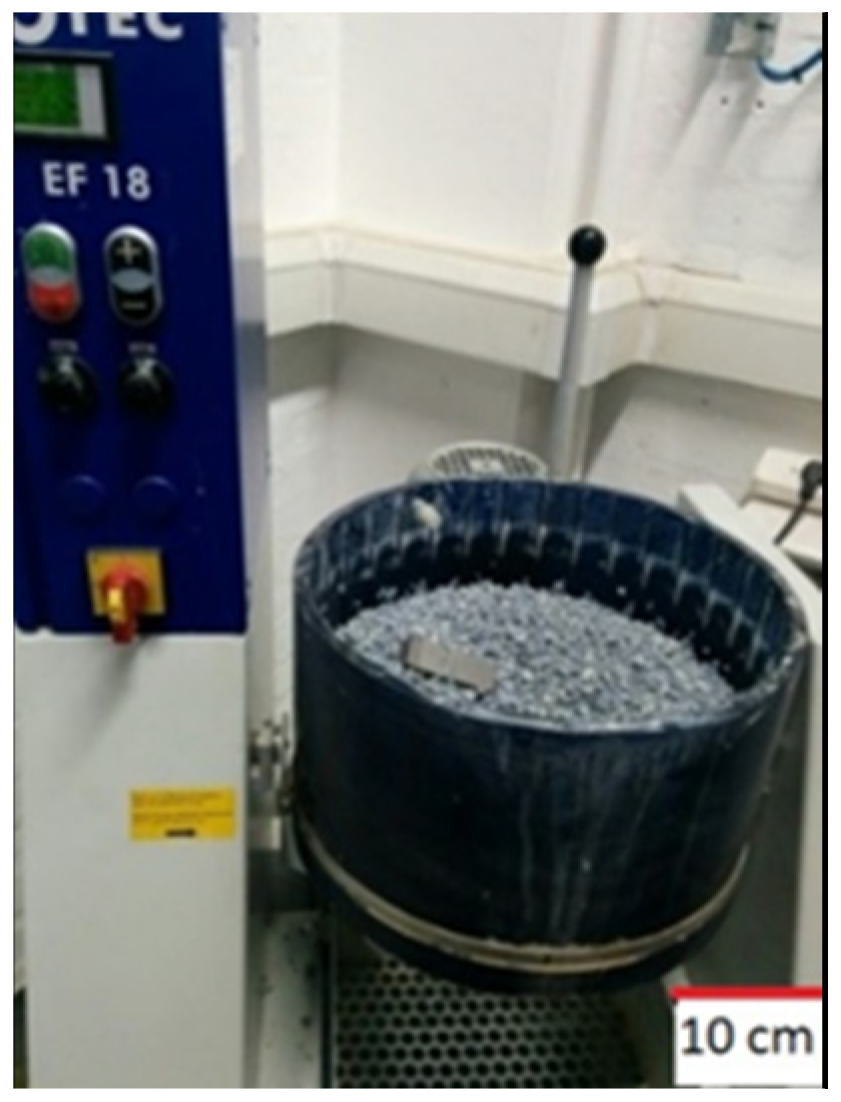
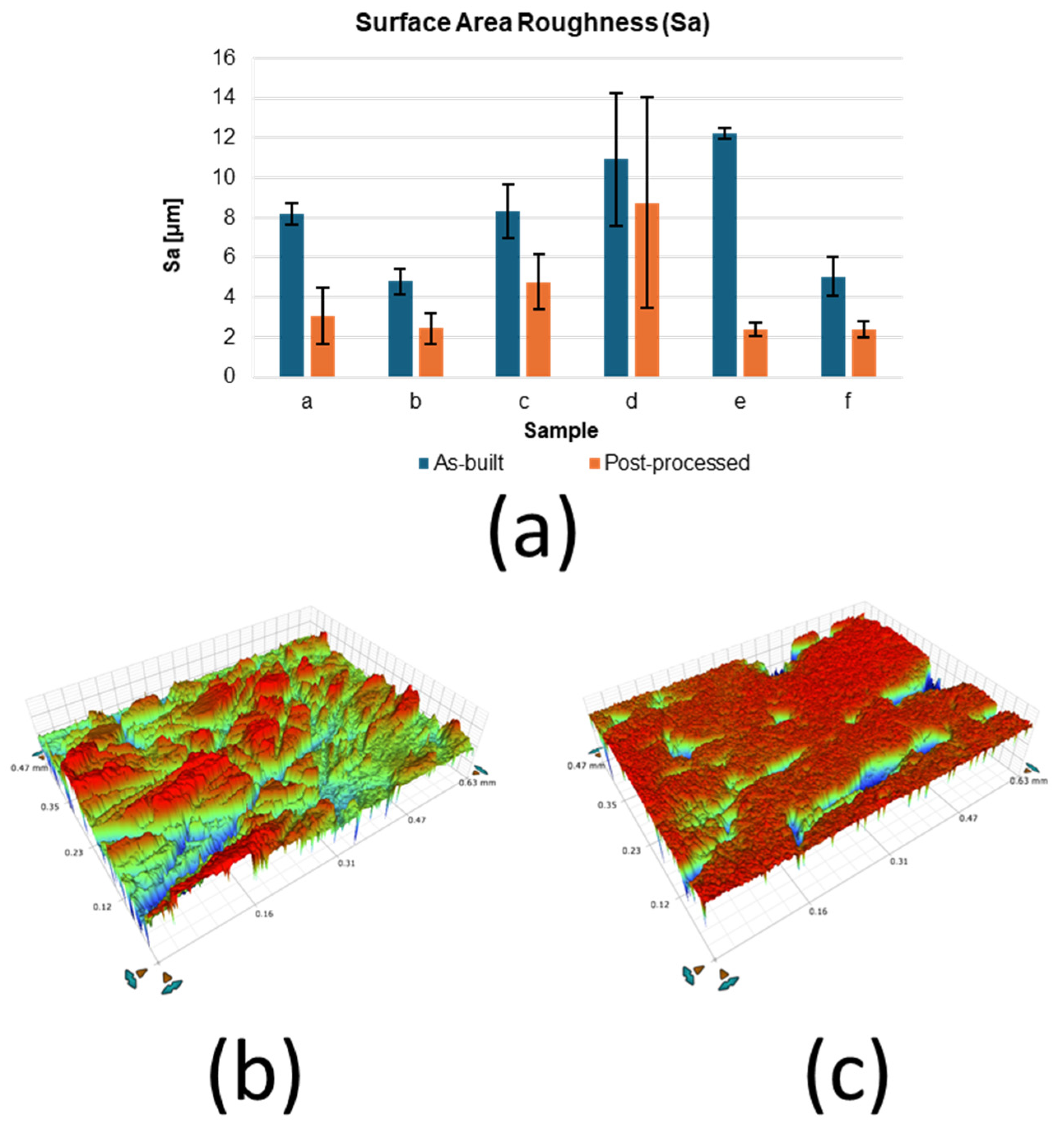
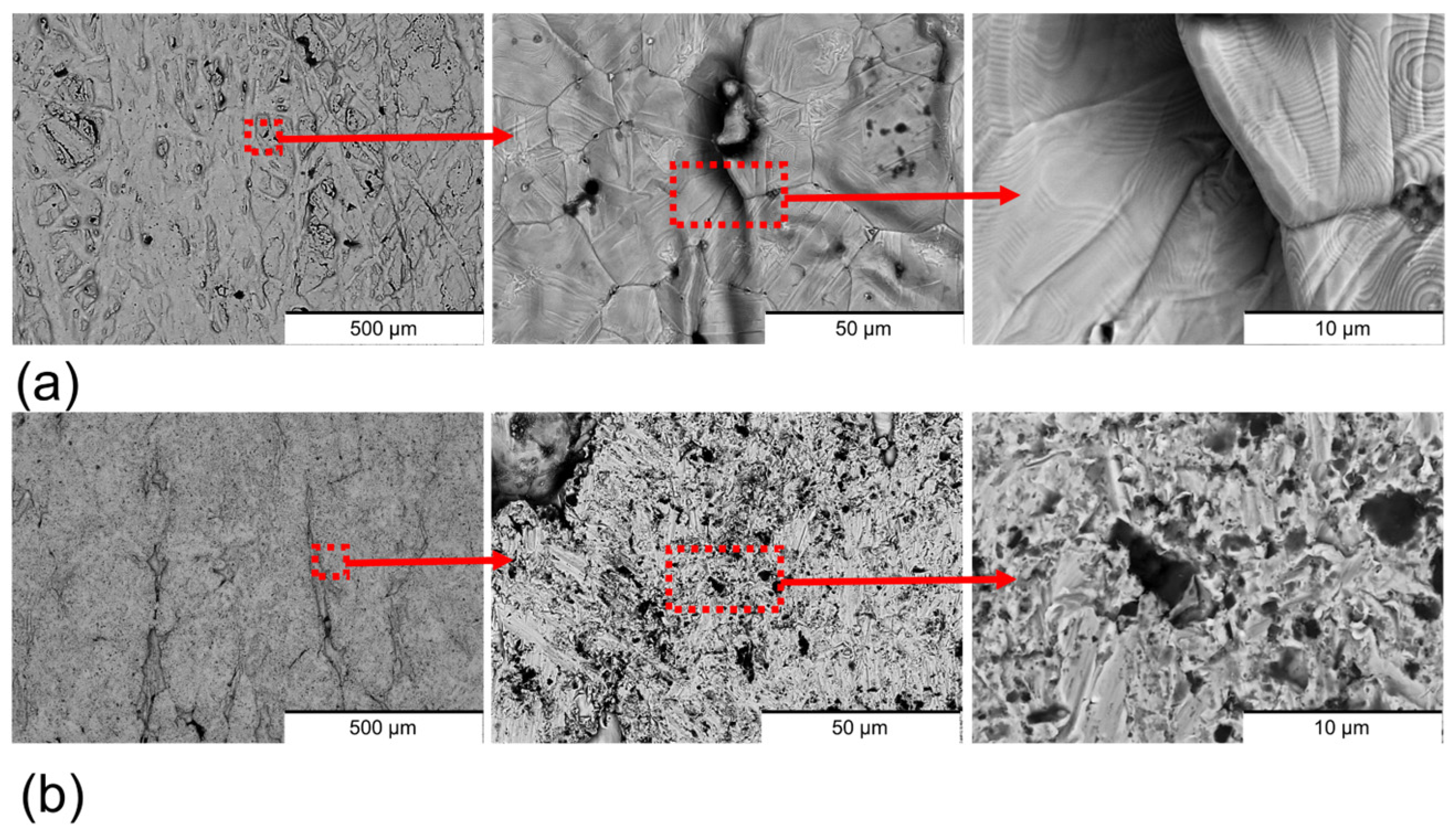
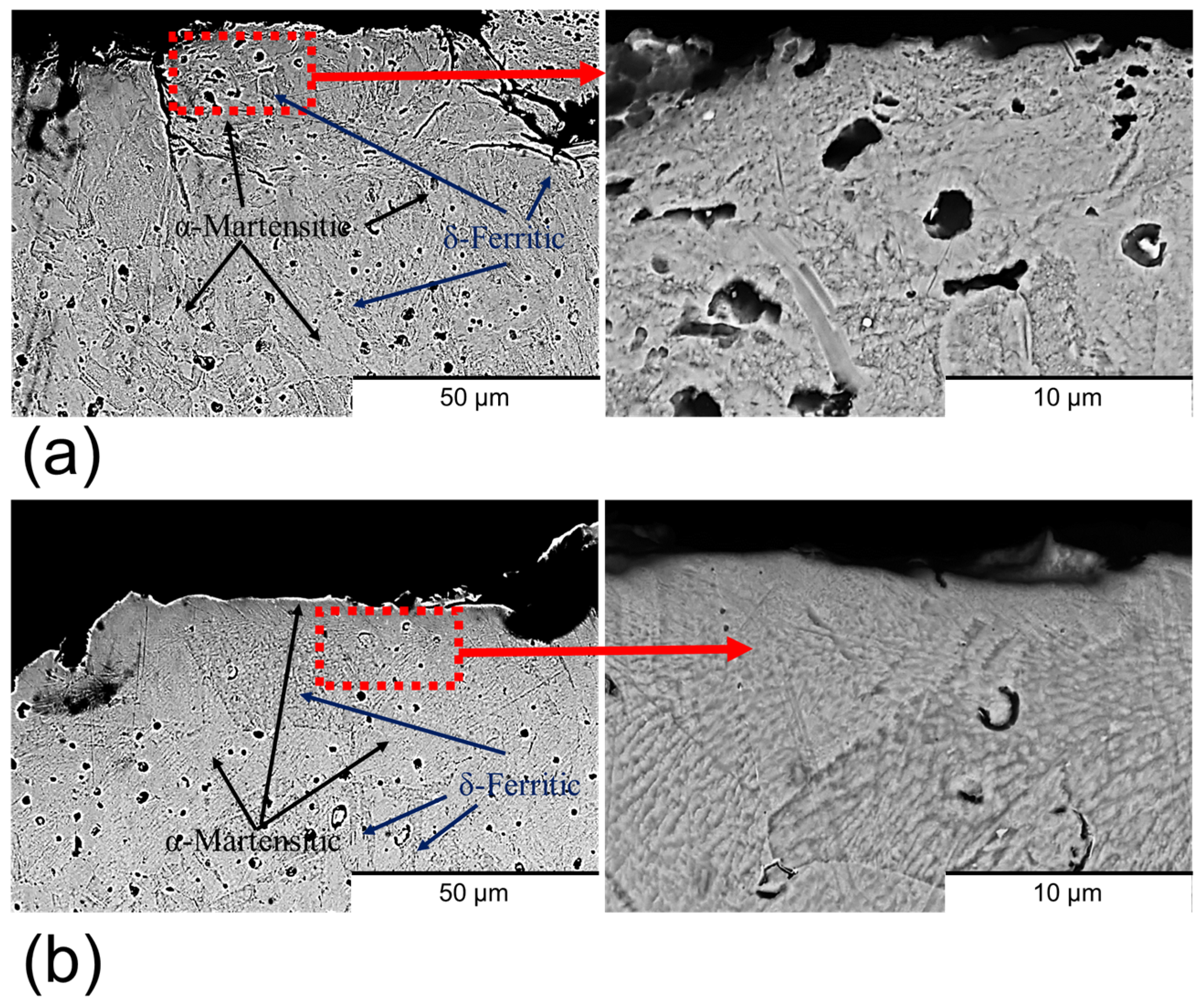


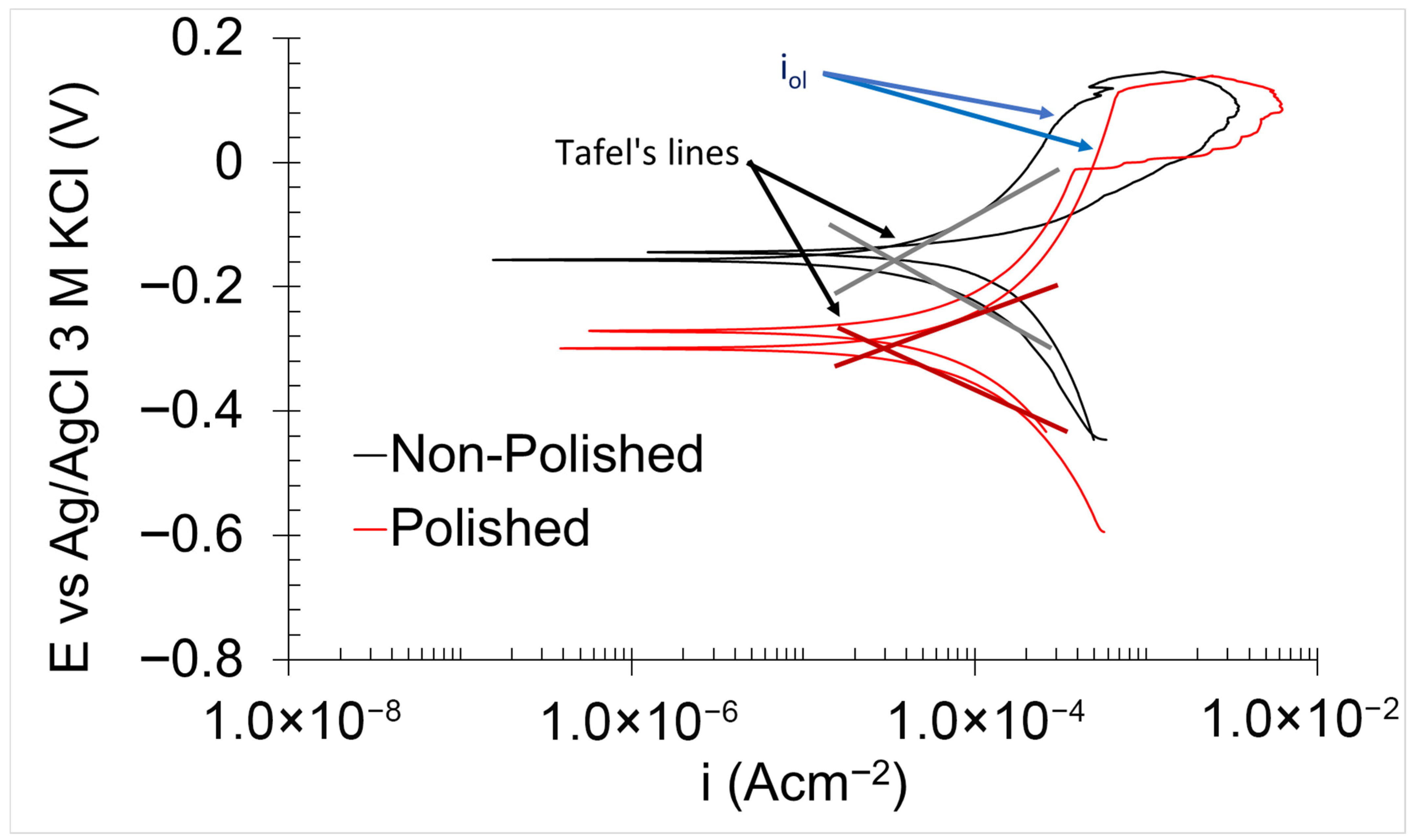





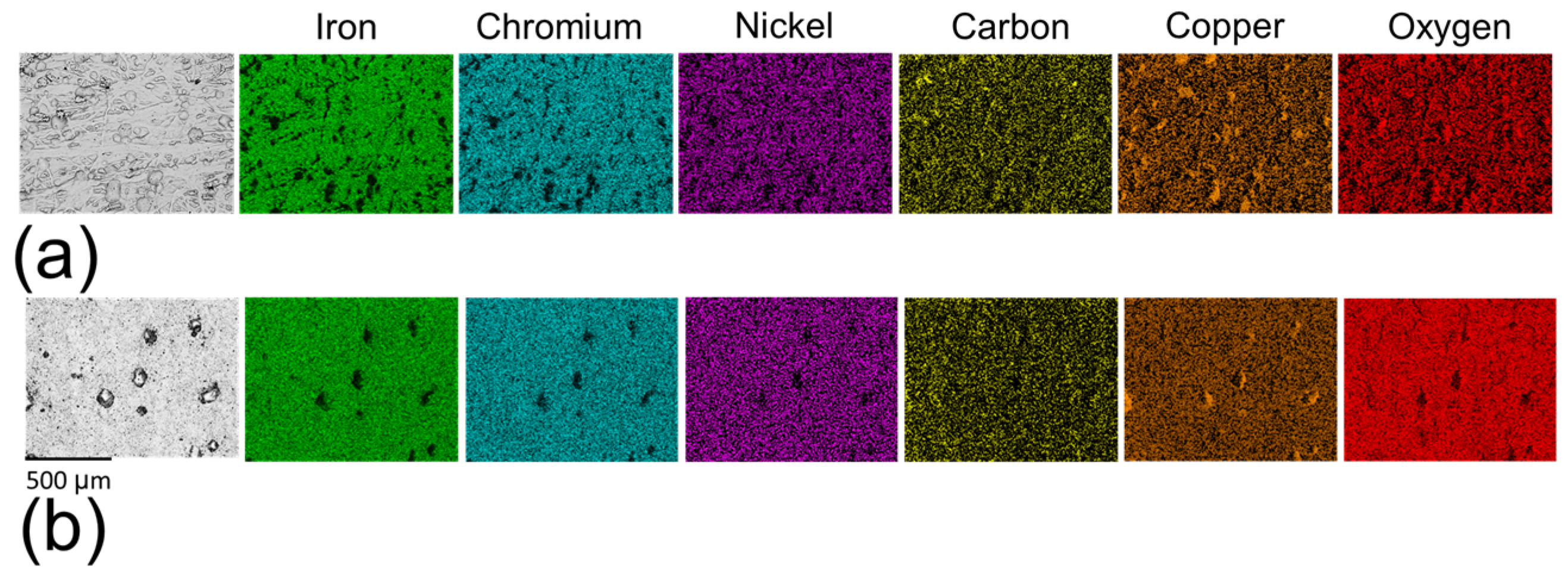
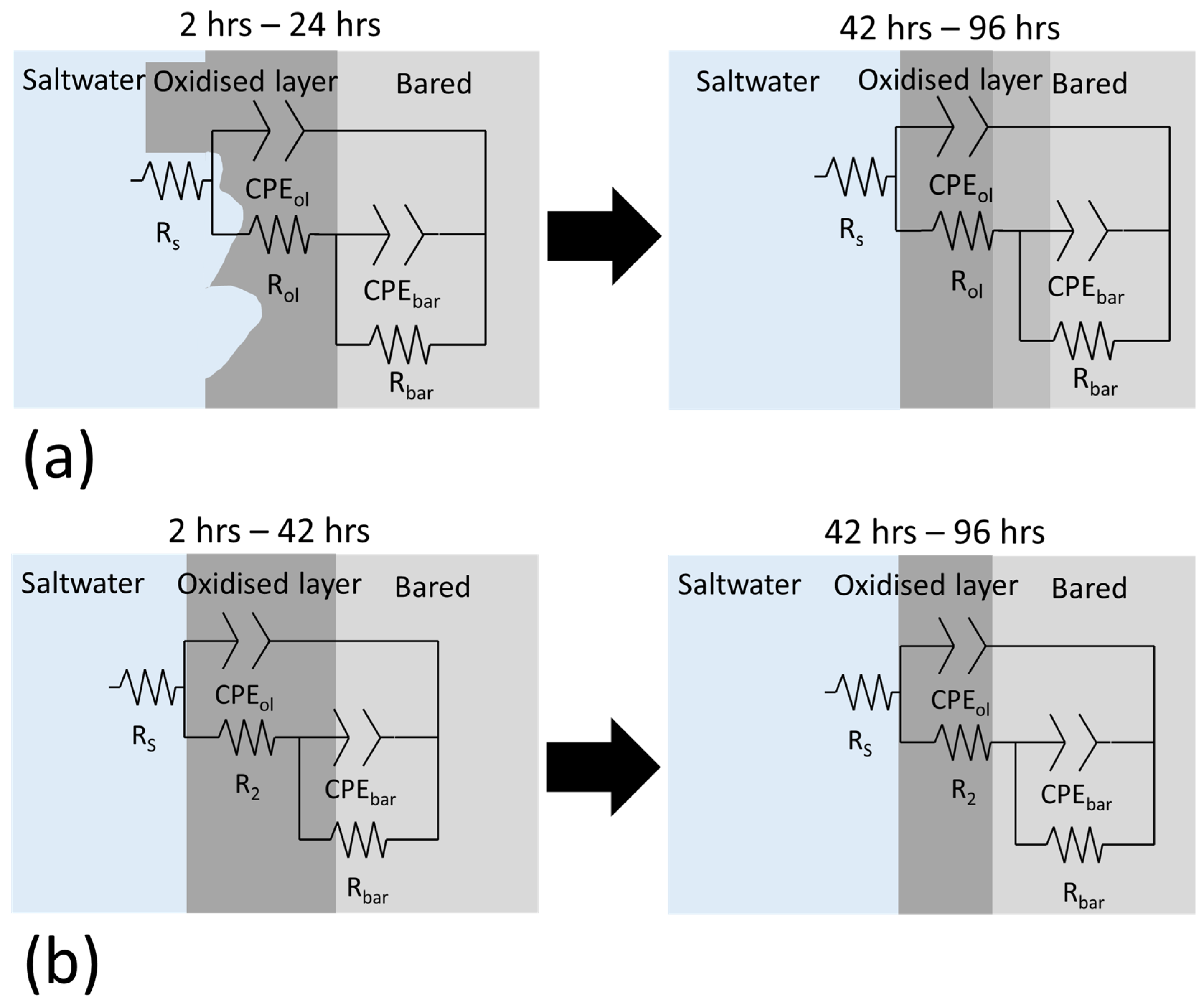
| Cr | Ni | Cu | Si | Mn | Nb | C | P | S | Fe | |
|---|---|---|---|---|---|---|---|---|---|---|
| Min–max | 15.00–17.50 | 35.00 | 35.00 | 1.00 | 1.00 | 0.15–0.45 | 0.07 | 0.04 | 0.03 | Balance |
| Sample | iR.M.S (Acm−2) | σi (Acm−2) | C.R.AEN (μms−1) | L.I. | σE (V) | RAEN (Ωcm2) |
|---|---|---|---|---|---|---|
| Non-polished | 4.3 × 10−5 ± 0.3 × 10−5 | 2.2 × 10−5 ± 0.1 × 10−5 | 329 ± 3 | 0.52 ± 0.02 | 0.032 ± 0.001 | 1.44 × 103 ± 0.03 × 103 |
| Polished | 2.1 × 10−5 ± 0.2 × 10−5 | 0.32 × 10−5 ± 0.01 × 10−5 | 162 ± 4 | 0.15 ± 0.01 | 0.062 ± 0.02 | 18.96 × 103 ± 0.05 × 103 |
| Sample | Ecorr (V) | Eol (V) | icorr (Acm−2) | βc | βa | Rp (Ωcm2) | iol (Acm−2) | C.R.corr (µm/Year) | C.R.ol (µm/Year) | Erol (V) |
|---|---|---|---|---|---|---|---|---|---|---|
| Non-polished | −0.16 ± 0.01 | 0.10 ± 0.01 | 3.8 × 10−5 ± 0.2 × 10−5 | −0.075 ± 0.005 | 0.072 ± 0.006 | 2.3 × 104 ± 0.2 × 104 | 3.8 × 10−4 ± 0.2 × 10−4 | 293 ± 1 | 2.9 × 103 ± 0.1 × 103 | −0.14 ± 0.01 |
| Polished | −0.30 ± 0.03 | 0.11 ± 0.01 | 4.6 × 10−5 ± 0.2 × 10−5 | −0.072 ± 0.005 | 0.074 ± 0.004 | 2.6 × 104 ± 0.2 × 104 | 4.1 × 10−4 ± 0.3 × 10−5 | 352 ± 1 | 3.2 × 103 ± 0.2 × 103 | −0.010 ± 0.001 |
| Sample | Immersion Time (h) | R1 (Ωcm2) | R2 (Ωcm2) | CPE2 (μFsn−1 cm−2) | n2 | R3 (Ωcm2) | CPE3 (μFsn−1 cm−2) | n3 | χ2 (10−4) |
|---|---|---|---|---|---|---|---|---|---|
| Non-polished | 2 | 4.55 | 56.44 | 0.27 | 0.71 | 0.87 × 106 | 23.51 | 0.93 | 9.40 |
| 24 | 4.61 | 45.00 | 0.18 | 0.73 | 1.10 × 106 | 18.72 | 0.94 | 10.68 | |
| 48 | 4.10 | 7.24 | 6.37 | 0.99 | 2.35 × 106 | 12.21 | 0.89 | 7.62 | |
| 72 | 4.32 | 5.19 | 6.29 | 0.98 | 2.98 × 106 | 11.90 | 0.89 | 5.84 | |
| 96 | 4.13 | 5.16 | 6.26 | 0.98 | 3.73 × 106 | 11.21 | 0.90 | 4.70 | |
| Polished | 2 | 4.31 | 13.61 | 87.10 | 0.84 | 0.87 × 106 | 72.03 | 0.55 | 4.61 |
| 24 | 3.33 | 1220.00 | 90.91 | 0.83 | 1.47 × 106 | 1.92 | 0.80 | 8.90 | |
| 48 | 3.80 | 93.00 | 82.62 | 0.83 | 1.31 × 106 | 2.66 | 1.00 | 4.90 | |
| 72 | 4.31 | 30.69 | 51.63 | 0.86 | 0.99 × 106 | 24.80 | 0.80 | 3.24 | |
| 96 | 4.26 | 29.67 | 51.82 | 0.86 | 1.12 × 106 | 18.73 | 0.84 | 2.61 |
| Sample | Nd (Electron/cm2) | Efbd (V) | Na (Holes/cm2) | Efba (V) |
|---|---|---|---|---|
| Non-polished | 1.76 × 1021 | −0.27 | 5.88 × 1020 | 0.31 |
| Polished | 2.94 × 1021 | −2.97 | 8.83 × 1020 | 0.42 |
Disclaimer/Publisher’s Note: The statements, opinions and data contained in all publications are solely those of the individual author(s) and contributor(s) and not of MDPI and/or the editor(s). MDPI and/or the editor(s) disclaim responsibility for any injury to people or property resulting from any ideas, methods, instructions or products referred to in the content. |
© 2025 by the authors. Licensee MDPI, Basel, Switzerland. This article is an open access article distributed under the terms and conditions of the Creative Commons Attribution (CC BY) license (https://creativecommons.org/licenses/by/4.0/).
Share and Cite
Ahuir-Torres, J.I.; Liu, X.; Chadwick, J.; Öpöz, T.T. An Electrochemical Study of the Corrosion Behaviour of the Polished Atomic Diffusion Additive Manufactured 17-4PH Stainless Steel Using Centrifugal Mass Finishing Method in Saltwater. Materials 2025, 18, 5148. https://doi.org/10.3390/ma18225148
Ahuir-Torres JI, Liu X, Chadwick J, Öpöz TT. An Electrochemical Study of the Corrosion Behaviour of the Polished Atomic Diffusion Additive Manufactured 17-4PH Stainless Steel Using Centrifugal Mass Finishing Method in Saltwater. Materials. 2025; 18(22):5148. https://doi.org/10.3390/ma18225148
Chicago/Turabian StyleAhuir-Torres, Juan Ignacio, Xiaoxiao Liu, Jackson Chadwick, and Tahsin Tecelli Öpöz. 2025. "An Electrochemical Study of the Corrosion Behaviour of the Polished Atomic Diffusion Additive Manufactured 17-4PH Stainless Steel Using Centrifugal Mass Finishing Method in Saltwater" Materials 18, no. 22: 5148. https://doi.org/10.3390/ma18225148
APA StyleAhuir-Torres, J. I., Liu, X., Chadwick, J., & Öpöz, T. T. (2025). An Electrochemical Study of the Corrosion Behaviour of the Polished Atomic Diffusion Additive Manufactured 17-4PH Stainless Steel Using Centrifugal Mass Finishing Method in Saltwater. Materials, 18(22), 5148. https://doi.org/10.3390/ma18225148








